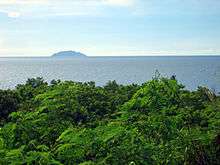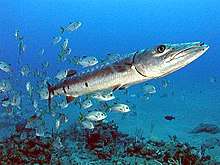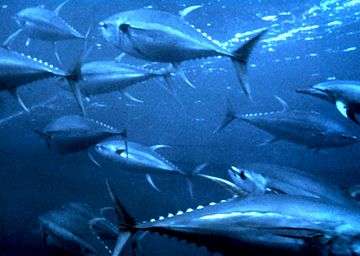Marine reserve
A marine reserve is a type of marine protected area that has legal protection against fishing or development. As of 2007 less than 1% of the world's oceans had been set aside in marine reserves.[1] Benefits include increases in the diversity, density, biomass, body size and reproductive potential of fishery and other species within their boundaries.[2]
As of 2010, scientists had studied more than 150 marine reserves in at least 61 countries and monitored biological changes inside the reserves. The number of species in each study ranged from 1 to 250 and the reserves ranged in size from 0.006 to 800 square kilometers (0.002 to 310 square miles).[3] In 2014, the World Parks Association adopted a target of establishing no-take zones for 30% of each habitat globally.[4]
Design
A review of studies of 34 families (210 species) of coral reef fishes demonstrates that the design of a marine reserve has important implications for its ability to protect habitat and focal species.[5]
Size and shape
Effective reserves included habitats that support the life history of focal species (e.g. home ranges, nursery grounds, migration corridors and spawning aggregations), and were located to accommodate movement patterns among them.[5]
Movement patterns (home ranges, ontogenetic shifts and spawning migrations) vary among and within species, and are influenced by factors such as size, sex, behaviour, density, habitat characteristics, season, tide and time of day. For example, damselfishes, butterflyfishes and angelfishes travel <0.1–0.5 km, while some sharks and tuna migrate over thousands of kilometres. Larval dispersal distances tend to be <5–15 km, and self-recruitment to new habitat is common.[5]
The review indicated that effective marine reserves are more than twice the size of the home range of focal/target species (in all directions). The presence of effective marine management outside the reserve may allow smaller reserves.[5] Reserve size recommendations apply to the specific habitats of focal species, not the overall size. For example, coral reef species require coral reef habitats rather than open ocean or seagrass beds.[2]
Marine reserve whose boundaries are extensively fished benefit from compact shapes (e.g., squares or circles rather than elongated rectangles). Including whole ecological units (e.g., an offshore reef) can reduce exports where that is desired.[2]
| Group | Species | Daily movements: home ranges, territories and core areas of use | Ontogenic shifts | Spawning | Long-term movements of unknown cause |
|---|---|---|---|---|---|
| Anemonefishes | Amphiprion spp. | .1 | |||
| Angelfishes | some, e.g. Centropyge spp. | .1 | |||
| Holocanthus/Pomacanthus spp. | .5 | ||||
| Butterflyfishes | Chaetodon spp. | .1 | |||
| some, e.g. Chaetodon striatus | .5 | ||||
| Chub | Bermuda sea chub (Kyphosus sectatrix) | 3 | |||
| Damselfishes | most, e.g. Dascyllus spp. | .1 | |||
| Eel | Indonesian shortfin eel (Anguilla bicolor bicolor) | 10 | |||
| Moray (Gymnothorax spp.) | .1 | ||||
| Emperor | e.g. Lethrinus nebulosus | 5 | |||
| Trumpet (L. miniatus) | thousands | ||||
| Filefish | Orange spotted (Cantherhines pullus) | .1 | |||
| Goatfishes | 1 | ||||
| Groupers | some, including most Cephalopholis spp. and Ephinephelus spp. | .1 | |||
| Squaretail coralgrouper (Plectropomus areolatus) | 1 | ||||
| some, e.g. C. sonnerati and E. coicoides | 5 | ||||
| Gag (Mycteroperca microlepis) | 20 | ||||
| Nassau (E. striatus) | hundreds | ||||
| Leopard coralgrouper (P. leopardus) | 3 | 10 | |||
| Grunts | e.g. Haemulon sciurus | 1 | |||
| Jobfish | Green jobfish (Aprion virescens) | 10 | |||
| Kingfishes | Seriola spp. | 5 | |||
| Manta rays | Manta spp. | hundreds | |||
| Marlin/swordfish | thousands | ||||
| Parrotfishes | some Scarus/Sparisoma spp. | .5 | |||
| Chlorurus spp., ember (S. rubroviolaceus) | 3 | ||||
| Blue-barred (S. ghobban) | 10 | ||||
| Bumphead (Bolbometopon muricatum) | 10 | ||||
| some, e.g. Scarus rivulatus | 1 | ||||
| Rabbitfishes | some, e.g. Siganus lineatus | 1 | |||
| Seahorses | Hippocampus spp. | .1 | |||
| Shark | lemon (Negaprion spp.) | 5 | |||
| Whitetip reef (Triaenodon obesus) and nurse (Ginglymostoma cirratum) | 10 | ||||
| Blacktip reef (Carcharhinus melanopterus) | 20 | hundreds | |||
| Galapagos (C. galapagensis) | hundreds | ||||
| Tiger (Galeocerdo cuvier) | thousands | ||||
| Shoemaker spinefoot | S. sutor | 5 | |||
| Silver drummer | (Kyphosus sydneyanus) | 5 | |||
| Snappers | some, e.g. Lutjanus carponotatus | .1 | |||
| some, e.g. L. ehrenbergii | .5 | ||||
| Red (L. campechanus) | 5 | ||||
| Mangrove red (L. argentimaculatus) | thousands | ||||
| Soldierfishes/squirrelfishes | Holocentrus spp./Myripristis spp. | .1 | |||
| Surgeonfishes | some (e.g. Acanthurus lineatus) | .1 | |||
| some, (e.g. A. coeruleus and Ctenochaetus striatus) | .5 | ||||
| some (e.g. A. blochii) | 5 | ||||
| Yellow tang (Zebrasoma flavescens) | 1 | ||||
| Twotone tang (Z. scopas) | 1 | ||||
| Sweetlips | Goldspotted (Plectorhinchus flavomaculatus) | 3 | |||
| Trevally | Bigeye (Caranx sexfasciatus) | 3 | thousands | ||
| Giant (C. ignobilis) | 20 | 5 | thousands | ||
| Triggerfish | Grey (Balistes capriscus) | 20 | |||
| Tuna | thousands | ||||
| Unicornfish | Bignose (e.g. Naso vlamingii) | .1 | |||
| Bluespine (N. unicornis) | 1 | ||||
| N. lituratus | 5 | ||||
| Wrasses | most (e.g., Halichoeres garnoti) | .1 | |||
| some (e.g. Coris aygula) | 5 | ||||
| Humphead (Cheilinus undulatus) | 10 |
Habitats
Minimum sustainable population sizes have not been determined for most marine populations. Instead, fisheries ecologists use the fraction of unfished stock levels as a proxy. Meta-analyses suggest that maintaining populations above ∼37% of those levels generally ensures stable populations, although variations in fishing pressure allow fractions as small as 10% or as large as 40% (to protect species such as sharks and some grouper that have lower reproductive output or slower maturation). Higher fractions of habitat protection may protect areas vulnerable to disturbances such as typhoons or climate change. 20–30% protection can achieve fisheries objectives in areas with controlled fishing pressure and is the minimum level of habitat protection recommended by IUCN-WCPA.
Special areas
Many fish species congregate to facilitate spawning. Such congregations are spatially and temporally predictable and increase the species' vulnerability to overfishing. Species such as groupers and rabbitfishes travel long distances to congregate for days or weeks. Such gatherings are their only opportunities to reproduce and are crucial to population maintenance. Species such as snappers and parrotfishes congregate in feeding or resting areas. Juveniles may congregate in nursery areas without adults. Such special areas may require only seasonal protections if at other times no vital activities are taking place. Such reserves must be spaced to allow focal species to journey among them. If the location of such special areas is unknown, or is too large to include in a reserve, management approaches such as seasonal capture and sales restrictions may provide some protection. Sea turtle nesting areas, dugong feeding areas, cetacean migratory corridors and calving grounds are examples of other special areas that can be protected seasonally. Other types of special areas include isolated habitats that have unique assemblages and populations, habitats that are important for endemic species and highly diverse areas.[2]
Isolated populations
Isolated populations (e.g.,those on remote atolls) have high conservation value where they harbor endemic species and/or unique assemblages. A location or population 20–30 km from its nearest neighbor generally qualifies as isolated in the absence of a persistent linking current. Their isolation (low connectivity) requires such areas to be largely self-replenishing. This leaves them less resilient to disturbance. Sustaining their marine species requires a higher fraction of living areas to be protected.[2]
Recovery
Coral reef fish species recovery rates (from e.g., overfishing) depend on their life history and factors such as ecological characteristics, fishing intensity and population size. In the Coral Triangle, species at lower trophic levels that have smaller maximum sizes, faster growth and maturation rates and shorter life spans tend to recover more quickly than species having the opposite characteristics. For example, in the Philippines, populations of planktivores (e.g., fusiliers) and some herbivores (e.g., parrotfishes) recovered in <5–10 years in marine reserves, while predators (e.g., groupers) took 20–40 years.[2] Increased fishing pressure adversely affects recovery rates (e.g., Great Barrier Reef and Papua New Guinea).[2]
Long-term protection allows species with slower recovery rates to achieve and maintain ecosystem health and associated fishery benefits. Permanent protection protects these species over the long-term. Short-term protections do not allow slow-recovering species to reach or maintain stable populations.[2]
In some Coral Triangle countries (e.g., Papua New Guinea and Solomon Islands), short term protections are the most common form of traditional marine resource management. These protections can help address problems at lower trophic levels (e.g., herbivores) or allow spawning to succeed. Other reasons for adopting short-term protections include allowing communities to stockpile resources for feasts or close areas for cultural reasons. Short-term/periodic reserves also may function as partial insurance by enhancing overall ecosystem resilience against catastrophes. Reopened reserves can be protected by management controls that limit the harvest to less than the increase achieved during closure, although at greatly reduced recovery rates.[2]
Resilience
Some habitats and species are better prepared environmental changes or extremes. These include coral communities that handle high sea surface temperature (SST); areas with variable SSTs and carbonate chemistry and areas adjacent to undeveloped low-lying inland areas that coastal habitats can expand into as sea levels rise. Such areas constitute climate change refugia and can potentially better protect biodiversity than more fragile areas. They may also provide fishery benefits, since habitat loss from climate change is a major fishery threat.[2]
Local practices
Local practices such as overfishing, blast fishing, trawling, coastal development and pollution threaten many marine habitats. These threats decrease ecosystem health and productivity and adversely affect focal and other species. Such practices can also decrease resilience. Some practices that originate beyond reserve boundaries (e.g., runoff) can be mitigated by considering their impacts within broader management frameworks. Areas that are not threatened by such practices and that are adjacent to other unthreatening areas may be better choices for reserves.[2]
Networks
Networks of marine reserves can support both fisheries management and biodiversity conservation. The size, spacing and location of reserves within a network must respect larval dispersal and movement patterns of species that are targeted for protection.[5]
Design
Existing ecological guidelines for designing networks independently focus on achieving either fisheries, biodiversity or climate change objectives or combinations of fisheries and biodiversity or biodiversity and climate change. These three goals have different implications for network design. The most important are reserve size and protection duration (permanent, long term, short term, or periodic closures).[2]
Diversity
Maintaining diversity involves protecting all species. Generally this involves protecting adequate examples of each major habitat (e.g., each type of coral reef, mangrove and seagrass community). Resiliency to threats improves when multiple examples of each habitat are protected.[2]
To address biodiversity or climate change, reserves 4–20 km across are recommended, because they protect larger populations of more species.[2]
Climate change
Protecting areas that have already proven resilient to ecological changes and/or are relatively well-protected by other protocols are likely to better survive climate change as well.[2]
Fisheries
Reserves 0.5–1 km across export more adults and larvae to fished areas, potentially increasing recruitment and stock replenishment there. Such small reserves are common in the Coral Triangle, where they benefited some fisheries.[2]
Connectivity
Connectivity is the linking of local populations through the (voluntary) dispersal of individuals. Connected reserves are close enough to each other that larvae, juveniles or adults can cross from one to another as their behavior patterns dictate. Connectivity is a key factor in network design, since it allows a disturbed reserve to recover by recruiting individuals from other, potentially overpopulated, reserves. Effective networks spaced reserves at distances of <15 km from each other, with smaller reserves spaced more closely.[5]
Most coastal fish species have a bipartite life cycle where larvae are pelagic before settling out of the plankton to live on a reef. While these fish travel varying distances during their life history, their larvae have the potential to move tens to hundreds of km, more than the more sedentary adults and juveniles, which have home ranges of <1 m to a few km. Adults and juveniles of some species travel tens to hundreds of kilometers as they mature to reach appropriate habitats (e.g., such as coral reef, mangrove and seagrass habitats) or to migrate to spawning areas. When adults and juveniles leave a marine reserve, they become vulnerable to fishing. However, larvae can generally leave a reserve without elevated risk because of their small size and limited fishery exposure. Effective networks account for the movement patterns of target species at each life cycle stage.[2]
Given a strong, consistent current, siting marine reserves upstream increases downstream populations.[2]
Other protected marine categories
Marine reserves are distinct marine parks, but there is some overlap in usage.
Open ocean reserves
As of April 2008 no high seas marine reserves had been established. Greenpeace is campaigning for the "doughnut holes" of the western pacific to be declared as marine reserves[6] and for 40 percent of the world's oceans to be so protected.[7]
By country or territory
Australia
- Great Barrier Reef Marine Park is the largest marine park, at 350,000 km2 or 217,000 miles2 and is partially a marine reserve.
- Great Australian Bight Marine Park
- Shark Bay Marine Park
British Indian Ocean Territory
- Chagos Marine Reserve is the largest 'no take' marine reserve with more than 540,000 km2
- It is said to be one of the world's richest marine ecosystems.[8]
- Hosts the world's biggest living coral structure - the Great Chagos Bank.[8]
- Home to more than 220 coral species, which is almost half the recorded species of the entire Indian Ocean.[8]
- Contains more than 1,000 species of reef fish.[8]
New Zealand
New Zealand has 37 marine reserves spread around the North and South Islands and other outlying islands.[9] These are 'no take' areas where all forms of exploitation are prohibited. Marine reserves are administered by the Department of Conservation. New Zealand's marine environment is more than 15 times larger than its terrestrial area,[10] however only 9.5% of New Zealand's territorial waters are in marine reserves, while 0.4% of New Zealand's exclusive economic zone (EEZ) is currently protected.[11]

United States
In 2000, waters around Desecheo Island in Puerto Rico received a Marine reserve designation and fishing is allowed within 0.5 miles (0.80 km) around the island.[12]
See also
- Marine park
- Marine Protected Area
References
- Ben Halpern. "Marine reserves".
- White, A. T.; Green, A. L. (2014). "Introduction". Coastal Management. 42 (2): 81–86. doi:10.1080/08920753.2014.877758.
- "The Science of Marine Reserves". Archived from the original on 2003-03-23.
- "World Parks Congress recommends target of 30% no-take MPA coverage worldwide" (PDF). MPA News. December 2014. Retrieved January 2015. Check date values in:
|access-date=(help) - Green, Alison L.; Maypa, Aileen P.; Almany, Glenn R.; Rhodes, Kevin L.; Weeks, Rebecca; Abesamis, Rene A.; Gleason, Mary G.; Mumby, Peter J.; White, Alan T. (2014). "Larval dispersal and movement patterns of coral reef fishes, and implications for marine reserve network design" (PDF). Biological Reviews. 90 (4): 1215–47. doi:10.1111/brv.12155. PMID 25423947.
- "The Pacific Commons -- first high seas marine reserve?". Greenpeace Australia Pacific. 2007. Retrieved 2008-04-27.
The Western and Central Pacific Ocean is the world's largest tuna fishery. Over half of the tuna consumed worldwide is taken from this area. Rampant overfishing is destroying this fishery; relatively healthy just a few years ago. Today, two key Pacific species, Bigeye and Yellowfin could face collapse unless urgent action is taken.
- "Marine reserves". Greenpeace Australia Pacific. 2007. Retrieved 2008-04-27.
A growing body of scientific evidence that demonstrates what we at Greenpeace have been saying for a long time: that the establishment of large-scale networks of marine reserves, urgently needed to protect marine species and their habitats, could be key to reversing global fisheries decline.
- "BBC News - UK sets up Chagos Islands marine reserve".
- "New marine reserves set up in subantarctic". nzherald.co.nz. Retrieved 2 March 2014.
- "Marine Protected Areas". Archived from the original on 2011-08-21. Retrieved 2012-05-04.
- Isaac.Davison@Nzherald.Co.Nz @Isaac_Davison, Isaac Davison Social Issues Reporter (2014-02-12). "Marine reserves south of NZ approved by MPs". NZ Herald. nzherald.co.nz. Retrieved 2 March 2014.
- Guia Informativa para la Pesca Recreativa en Puerto Rico (aka, Reglamento de Pesca de Puerto Rico). Caribbeanfmc.com. Estado Libre Asociado de Puerto Rico. Departamento de Recursos Naturales y Ambientales. Negociado de Pesca y Vida Silvestre. 3rd Edition. 2011. Appendix 2. Page 20. Accessed 24 March 2016.
Further reading
- Halpern, B.; Warner, R. (2002). "Marine reserves have rapid and lasting effects". Ecology Letters. 5 (3): 361–366. doi:10.1046/j.1461-0248.2002.00326.x.
- Russ, G. R.; Alcala, A. C. (2004). "Marine reserves: long-term protection is required for full recovery of predatory fish species". Oecologia. 138 (4): 622–627. doi:10.1007/s00442-003-1456-4. PMID 14716555.
External links
| Wikimedia Commons has media related to Marine reserves. |
- "Marine Reserves Factsheet". Waitt Institute. Retrieved 2015-06-08.
- Greenpeace is calling for a global network of Marine reserves
- Waitt Foundation Marine Protected Areas
- MPAtlas.org

